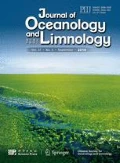Abstract
Maximum rate of food consumption (C max) was determined for juvenileSebastodes fuscescens (Houttuyn) at water temperature of 10, 15, 20 and 25°C. The relationships ofC max to the body weight (W) at each temperature were described by a power equation: InC max=a+b InW. Covariance analysis revealed significant interaction of the temperature and body weight. The relationship of adjustedC max to water temperature (T) was described by a quadratic equation:C max=−0.369+0.456T−0.0117T 2. The optimal feeding temperature calculated from this equation was 19.5 °C. The coefficients of the multiple regression estimation relatingC max to body weight (W) and water temperature (T) were given in the Table 2.
Similar content being viewed by others
References
Buckel, J. A., N. D. Steinberg, D. O. Conover, 1995. Effects of temperature, salinity, and fish size on growth and consumption of juvenile bluefish.J. Fish Biol. 47:696–706.
Clapp, D. F., D. H. Wahl, 1996. Comparison of food consumption, growth, and metabolism among muskellunge: at investigation of population differentiation.Trans. Am. Fish. Soc. 125:402–410.
Cui, Y., J. Liu, 1990. Comparison of energy budget of six teleosts—I. Food consumption, faecal production and nitrogenous excretion.Comp. Biochem. Physiol. 96A:163–171.
Cui, Y., R. J. Wootton, 1988. Bioenergetics of growth of a cyprinid,Phoxinus phoxinus (L.): the effect of ration, temperature and body size on food consumption, faecal production anc nitrogenous excretion.J. Fish Biol. 33:431–443.
Elliott, J. M., 1975. Number of meals in a day, maximum weight of food consumed in a day and maximum rate of feeding for brown trout.Salmo trutta L.Freshwat. Biol. 5:287–303.
Elliott, J. M., 1979. Energetics of freshwater teleosts.Symp. Zool. Lond. 44:29–61.
Ellis, C. S., W. O. Watanabe, E. P. Ellis, 1997. Temperature effects on feed utilization and growth of postsettlement stage Nassau grouper.Trans. Am. Fish. Soc. 126:309–315.
Fonds, M., V. P. Saksens, 1977. The daily food intake of young soles (Solea solea L.) in relation to their size and the water temperature.Actes de colloques du C. N. E. X. O. 4:51–58.
Gross, W. L., E. W. Roelots, P. O. Fromm, 1965. Influence of photoperiod on growth of green sunfish,Lepomis cyanallus. J. Fish. Res. Bd Can. 22:1379–1386.
Hron, M. H., R. N. Gibson, 1990. Effects of temperature on the food processing of three species of seaweed-eating fishes from European coastal waters.J. Fish Biol.,37:237–247.
Imsand, A. K., L. M. Sunde, A. Folkvord, S. O. Stefansson, 1996. The interaction of temperature and fish size of juvenile turbot.J. Fish Biol. 49:926–940.
Jobling, M., 1983. Influence of body weight and temperature on growth rate of Arctic charr,Salvelinus alpinus (L.).J. Fish Biol. 22:471–475.
Liu, J., Y. Cui, J. Liu, 1998. Food consumption and growth of two piscivorous fishes, the mandarin fish and the Chinese snakehead.J. Fish Biol. 53:1071–1083.
Vivekanandan, E., 1977. Surfacing activity and food utilization in the obligatory air-breeding fishOphiocephalus striatus as a function of body weight.Hydrobiologia 55:99–122.
Wootton, R. J., J. R. M. Allen, J. Cole, 1980. Effect of body weight and temperature on the maximum daily food consumption ofGasterodteus aculeatus L. andPhoxinus phoxinus (L.): selecting an appropriate model.J. Fish Biol. 17:695–705.
Xie, X., Y. Sun, 1992. Maximum ration level in the southern catfish (Silurus meridionalis Chen) in relation to body weight and temperature.Acta Ecologica Sinica 12:225–231. (in Chinese).
Zanuy, S., M. Carrillo, 1985. Annual cycles of growth, feeding rate, gross conversion efficiency and hetematocrit levels of sea bass (Dicentrarchus labrax L.) adapted to two different osmotic media.Aquaculture 44:11–25.
Author information
Authors and Affiliations
Corresponding author
Additional information
Contribution No. 4446 from the Institute of Oceanology, Chinese Academy of Sciences. This research was financially supported by the NSFC (No. 30000125), the Knowledge Innovation Key Projects of CAS (KZCX-SW-211). Funds for Major State Basic Research Projects (No. G1999012012), the Chinese Postdoctoral Foundation, and K. C. Wang Postdoctoral Foundatior Chinese Academy of Sciences.
Rights and permissions
About this article
Cite this article
Songguang, X., Hongsheng, Y., Yi, Z. et al. Effects of body weight and water temperature on maximum food consumption of juvenileSebastodes fuscescens (Houttuyn). Chin. J. Ocean. Limnol. 22, 83–88 (2004). https://doi.org/10.1007/BF02842804
Received:
Accepted:
Issue Date:
DOI: https://doi.org/10.1007/BF02842804


